Join Our Groups
TOPIC 5: MATTER
Concept of matter
Concept of Matter
Explain concept of matter
Matter is anything that has mass and occupies space. Therefore, anything around us provided it has mass and can occupy the space, is termed as matter. There are many kinds of matter. Can you mention some? The word matter is used to cover all the substances and materials from which the earth and universe is composed of. These include all materials around us such as water, soil, plants, animals, air, clothes, etc.
Any particular kind of matter is called a substance. Substances include elements and compounds. An element is a substance which is the limit of chemical analysis. When two or more elements are combined chemically, a compound is formed. Matter is made up of atoms, ions or molecules. You will learn more about this later.
States of matter
The Three States of Matter
Describe the three states of matter
Any chemical substance we study exists in any of the three forms (or physical states). The three different states of matter are
- solid state
- liquid state and
- gaseous states
So, each of the many millions of substances around us can be classified as a solid, a liquid or gas. Look around you and name substances that are solids, liquids and gases. The state in which any matter exists depends on temperature and sometimes pressure conditions. One substance may exist as a solid in one condition and as a liquid or gas under a different condition. Water is an example of such substances. This change is called a change in the state of matter.
The three physical states of matter differ in the way they respond to temperature and pressure. All three states can increase in volume (expansion) when the temperature is increased. They decrease in volume (contraction) when the temperature is decreased. Gases are easily compressed. Liquids are only slightly compressible. Solids are incompressible. They are not affected by change in pressure.
Investigation of the compressibility of solids, liquids and gases
Procedure
- Take three new syringes and fill them with sand, water and air respectively (figure 5.1).
- Try to push in the end of each syringe.
- Observe what happens.
Figure

Compressibility of solids, liquids and gases
Observation
Which of the substances under investigation can compress into a smaller volume?
Findings
You should have found that a solid (sand) and a liquid (water) cannot be compressed but a gas (air) is easily compressed.
The three states of matter differ in their physical properties. These differences in properties are summarized in table bellow
Differences in properties of the three states of matter
| Property | Physical state | ||
| Solid | Liquid | Gas | |
| Shape | has a definite shape | no definite shape, takes shape of the container | no definite shape, occupy whole container |
| Volume | has a fixed volume | has a fixed volume | variable (depending on temperature and pressure) |
| Fluidity | does not flow | generally flows easily | flows easily |
| Expansion on heating | low | medium | high |
| Compressibility | incompressible | almost incompressible | highly compressible |
| Motion of particles | slow | high | very high |
| Density | high | moderate to high | low |
| Tangibility | tangible | tangible | intangible |
| Visibility | visible | visible | invisible |
One State of Matter to Another
Change one state of matter to another
We have seen that matter exists in three different states - solids, liquids and gases. We can use the kinetic theory of matter to explain how a substance changes from one state to another. Basically, changes from one state to another are caused by alterations in temperature and pressure. Normally molecules, ions or atoms of a substance move faster when the temperature is increased.
Melting and freezing
Melting is a change from solid to liquid state. When solids are heated, their constituent particles (atoms, molecules or ions) get energy and vibrate more violently. Vibrations of these particles overcome (exceed) their binding forces. The particles become mobile. The crystalline structure of solid is destroyed. A liquid state is reached and the particles are free to move. The temperature at which this happens is called melting point of the solid.
The melting point of a solid tells us something about the strength of forces holding its constituent particles together. Substances with high melting points have strong forces between their particles. Those with low melting points have weak forces between their particles.

Change in state from solid to liquid
Freezing is a change from liquid to solid state. Freezing is the opposite of melting. The process is reversed at the same temperature if a liquid is cooled. The temperature at which a substance turns to a solid is called freezing point. The melting point and freezing point of any given substance are both the same. For example, the melting and freezing of pure water takes place at 0°C. Melting is not affected by any changes in atmospheric pressure.
Evaporation and boiling
Boiling is a change from liquid to vapour state at a particular temperature. Evaporation is the change from liquid to vapour state at any given temperature. If a liquid is exposed to open air, it evaporates. Splashes of water evaporate at room temperature. After rain, small pools of water dry up. When a liquid changes into a gas at any temperature, the process is called evaporation.Evaporation takes places from the surface of the liquid. The larger the surface area, the faster the liquid evaporates. The warmer the liquid is, the faster it evaporates. Thus, surface area and temperature affects the rate of evaporation of a liquid.
When a liquid is heated, its molecules get more energy and move faster. They knock into each other violently and bounce further apart. As the heating goes on, its molecules vibrate even faster. Bubbles of gas (due to air dissolved in water) appear inside the liquid. The whole process is called boiling. The temperature at which a liquid boils is called boiling point.
The molecules at the surface of the liquid gain enough energy to overcome the forces holding them together. They break away from the liquid and from a gas (vapour). As more of the liquid molecules escape to form a gas, a liquid is said to evaporate. This occurs at the boiling point of a liquid.
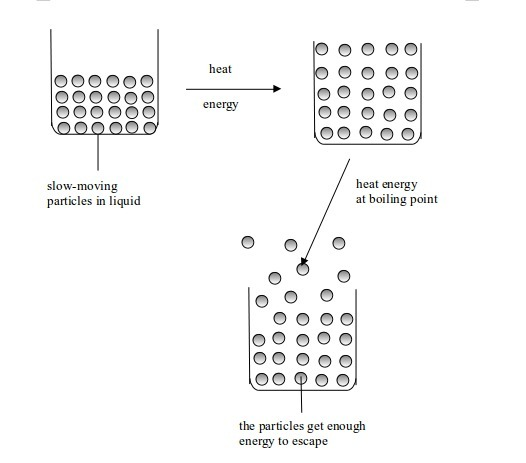
Change in state from liquid to gas
The temperature at which a liquid boils explains how strong the forces holding its particles (molecules) together are. Liquids with high boiling points have strong forces of attraction between their molecules than those liquids with low boiling points.
The boiling point of a liquid can change if the surrounding pressure changes. If the surrounding pressure falls, the boiling point also falls. The boiling point of water at standard pressure (760 mmHg) is 100°C. On a high mountain, where pressure is low, it is lower than 100°C. If the surrounding pressure is increased, the boiling point rises. The same behaviour is experienced by a gas when the pressure is either increased or decreased.
The melting and boiling points of some common chemical substances at standard temperature and pressure (s.t.p)
| Substance | Physical state at room temperature (20°C) | Melting point (°C) | Boiling point(°C) |
| Oxygen | gas | -219 | -183 |
| Nitrogen | gas | -210 | -196 |
| Ethanol (alcohol) | liquid | -117 | 78 |
| Water | liquid | 0 | 100 |
| Sulphur | solid | 115 | 444 |
| Common salt (sodium chloride) | solid | 801 | 1465 |
| Copper | solid | 1083 | 2600 |
| Carbon dioxide | gas | sublimation point (°C): -78 | |
From the above explanation, obvious differences between evaporation and boiling can be detected. See table bellow
| Evaporation | Boiling |
| 1.Occurs at all temperatures | Occurs at one particular temperature (boiling point) |
| 2.Occurs on the surface of the liquid | Occurs both inside and on the surface of the liquid |
| 3.Takes place slowly | Takes place faster |
| 4.Bubbles are not necessarily formed | Bubbles are formed |
Therefore, the two terms can be defined as follows: Evaporation is a change in state of a substance from liquid to gas (vapour) state at any temperature.
Boiling is a change in state of a substance from liquid to gas at a particular temperature and pressure.
Condensation and solidification
The reverse of evaporation is condensation. This is brought about by cooling. When a gas is cooled down, its particles lose energy. They move more and more slowly. When they knock into each other, they do not have enough energy to bounce away again. They stay close together and a liquid forms. This process is called condensation. When the liquid is cooled further, the movement of the particles slows down even more. Eventually, they stop moving and a solid forms. This is called solidification.
Condensation can be defined as a change in state of a substance from gas (vapour) to liquid. Solidification is a change from liquid to solid state of a substance. Solidification is the same as freezing.
Sublimation
A few solids do not melt when they are heated. Instead, they change directly from the solid to gaseous state without passing through the liquid state. This change in state is called sublimation. When a solid changes directly into gas, it is said to sublime. Iodine, solid carbon dioxide ("dry ice") and ammonium chloride are examples of solids that sublime. Like melting, sublimation also occurs at one particular temperature for each pure solid.
The Importance of Changing One State of Matter to Another
Explain the importance of changing one state of matter to another
The following points summarize the importance of change in state:
1. Separation of mixtures
Different mixtures can be separated through such processes as distillation, sublimation, evaporation and condensation. Let us have a look at an example of distillation. This process involves boiling, evaporation and condensation. Distillation as a process can be applied in separation of a mixture (solution) of two or more substances. A mixture of two or more substances with different boiling points e.g. water and alcohol can be separated by this means. In such a case, a container with the mixed-up liquids is heated. The liquid with a low boiling point evaporates and condenses first, leaving the one with a high boiling point in the container. The distillate (liquid with low boiling point) is collected, cooled down and transferred into another container.
2. Industrial manufacture of products
Industrially, the process of distillation is applied in the production of pure substances such as beer and other alcoholic drinks such as wine, vodka, konyagi, etc. The manufacturing process involves boiling, evaporating and condensation.
3. Refining of petroleum (crude oil)
Crude oil contains organic liquid components, each with a different boiling point. In the refinery, the components with lower boiling points evaporate first and get separated out, leaving those with higher boiling points behind. In this way, we get various types of oil components (fractions) such as petrol, diesel, kerosene, lubricating oil, etc.
4. Drying of crops and clothes
When you suspend your clothing on a cloth line to dry, the moisture in it is lost through evaporation. Likewise, farmers in the village often spread crops on the ground to dry. They do this in order to reduce moisture content and hence prevent decaying. The moisture contained in crops leave by evaporation. Therefore, you can notice how evaporation, as a change in state, is important in everyday lives.
5. Cooling of our bodies in hot weather
You all like to drink cold water or beverages especially during hot weather. You can use a refrigerator to cool down drinking water or beverages directly. Alternatively, you can freeze water into ice and then use the resulting ice for cooling the beverage. Ice blocks are also saleable. Moreover, one can earn some money if she freezes water into ice blocks and then sells them to beverage vendors. Perishable products such as fish, meat, milk, etc are often packed in ice blocks to prevent them from going bad. Ice, as we studied early, is formed when water freezes (a change in state from liquid to solid).
6. Ice formation in refrigerators
You all like to drink cold water or beverages especially during hot weather. You can use a refrigerator to cool down drinking water or beverages directly. Alternatively, you can freeze water into ice and then use the resulting ice for cooling the beverage. Ice blocks are also saleable. Moreover, one can earn some money if she freezes water into ice blocks and then sells them to beverage vendors. Perishable products such as fish, meat, milk, etc are often packed in ice blocks to prevent them from going bad. Ice, as we studied early, is formed when water freezes (a change in state from liquid to solid).
7. Melting metals to make alloys
In metallurgical industries, need may arise to mix two or more metals (alloys) together. This is only possible, where two or more metals are first melted at high temperatures into liquids. Then the resulting liquid metals are mixed in appropriate proportions. This is followed by cooling down the mixture to a solid alloy. Normally alloys have better qualities than individual metals.
8. Testing the purity of substances
The presence of impurity may lower or raise the boiling point of the substance. A pure substance melts and boils at definite temperatures (see table 5.4). The values for the melting point and boiling point are precise and predictable. This means that we can use them to test the purity of a sample. They can also be used to check the identity of unknown substance.
A typical example
Sea water is impure. It freezes at a temperature well below the freezing point of pure water (0°C) and boils at a temperature above the boiling point of pure water (100°C). Other substances behave in a similar manner. So, boiling as a change in state can be used to test for the purity of a substance.
In addition, the impurity also reduces the exactness of the melting or boiling point. An impure substance melts or boils over a range of temperature, not at a particular point.
Melting and boiling points of some pure substances
| Substance | Melting point (°C) | Boiling point (°C) |
| Water | 0 | 100 |
| Ethanol | -117 | 78 |
| Oxygen | -219 | -183 |
| Sodium | 98 | 890 |
| Sulphur | 119 | 445 |
| Iron | 1540 | 2900 |
| Diamond | 3550 | 4832 |
| Cobalt | 1492 | 2900 |
| Nitrogen | -210 | -196 |
| Propane | -188 | - 42 |
| Ethanoic acid | 16 | 118 |
9. Formation of rain
Perhaps the most important of all, as far as change in state is concerned, is the formation of rain. Rained is mainly formed through the process of evaporation and condensation. Water vapour, evaporating mostly from water bodies (oceans, seas, lakes, rivers, ponds, etc), land and plants rises up to the sky. As it rises, it cools down and condenses into tiny droplets
On further cooling as they rise up, these droplets form bigger water drops. Owing to gravitational force, these drops fall down as rainfall. Every one of you knows how important rain is to our life. Therefore, you have noticed how evaporation and condensation, as changes in state, contribute to rain formation.
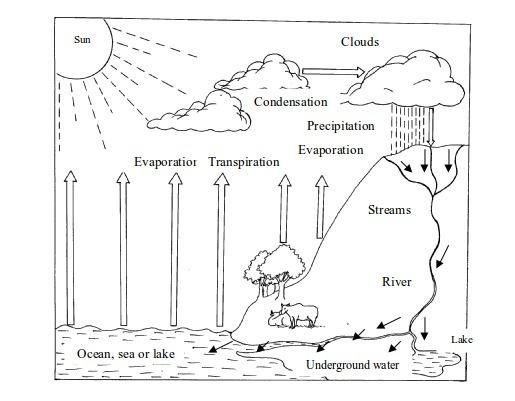
Rain formation
Kinetic nature of matter
We already know that matter is composed of atoms, ions or molecules. We have not yet considered the reason why the same substance, say water, can exist in more than one form, for example as solid ice, liquid water, and gaseous steam. But does matter behave like that?
The kinetic theory of matter has been used to explain the way in which the arrangement of the particles of a substance can determine the properties of that substance, and particularly the state in which it is likely to be found under a given set of conditions. The idea is that all matter is made up of tiny moving particles. The main points of the theory are as follows:
- All matter is made up of tiny particles (atoms and molecules) that are invisible to the naked eye and to most microscopes.
- The particles are moving all the time. The higher the temperature is, the higher the average energy of the particles.
- Heavier particles move more slowly than lighter particles at the same temperature.
- Each substance has unique particles that are different from the particles of other substances.
- The particles of matter are held together by strong electrostatic forces.
- There are empty spaces between the particles of matter that are very large compared to the particles themselves.
The solid state
In the solid state, the particles are so closely packed (see figure bellow. The particles are held together by strong forces of attraction that act like a chemical glue. Free movement of particles cannot take place. They cannot move around freely in this arrangement. Instead, they vibrate about a fixed position. They are arranged in a fixed pattern which form a cluster of vibrating masses. This makes a solid to have a fixed shape, which cannot be changed except by applying strong external forces.
The liquid state
The particles of a liquid are also closely packed but the forces of attraction between them are weaker than of a solid. These forces of attraction tend to bind them together. The particles have more kinetic energy and they can move around each other. The binding forces are strong when particles come close to one another. It is thought that the particles of a liquid are fairly randomly arranged but consist of "clusters" closely packed together. This property makes a liquid to have a definite volume. However, since the particles are fairly free to move a liquid does not have any characteristic shape (see figure 5.5(b). Thus, a liquid will always take the shape of its container.
The gaseous state
The gaseous state is one in which the particles are moving independently of each other in all directions and at great speeds. The particles of a gas are relatively far apart. They exert no force of attraction on each other. They have more energy than the particles of solids and liquids. They move rapidly and randomly, colliding with each other and with the walls of the container. A typical speed for a molecule of hydrogen in air at ordinary temperature and pressure has been found to be approximately 500 ms-1
It has been estimated that a nitrogen molecule makes collisions each second. Thus, a gas will rapidly spread out to fill any container in which it is placed. A gas cannot have any shape of its own.
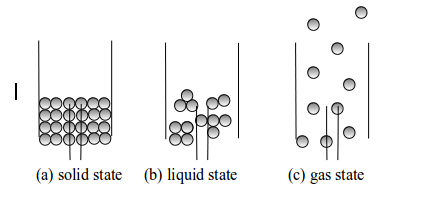
Three states of matter
Physical and chemical changes
Depending on the nature of change, all changes that matter undergoes can be classified as either physical or chemical.
The Characteristics of a Physical Change
Describe the characteristics of a physical change
Physical change
Substances may undergo changes in their physical properties e.g. changes in colour, shape (or form), state, density, structure and texture, etc. If you take a stone and break it down into small particles, you will have only changed its form, but it will remain as a stone. Likewise, melting ice to water or freezing water to ice does not change it, but it is still water. The same case happens when you dissolve salt in water to get a solution of salt in water. You can still get back the original salt by evaporation, except that the crystals of the salt obtained will not look exactly the same as those of the original salt.
These changes of state are examples of physical changes. Physical changes such as melting and boiling do not result in new substances being formed
For example, ice and water still contain the same particles whether in solid (ice) liquid (water) or gaseous (vapour) state.
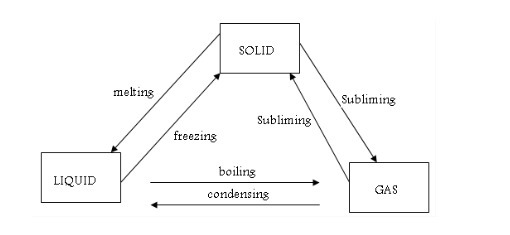
Changes in states
Characteristics
In the explanation above, we find that in a physical change it is only the physical form, and not the actual nature, of a substance that changes. The changes are brought about by a mere addition or removal of heat, as in the case with water or ice. Such a change is called a physical change. It can be distinguished by the following characteristics:
- There is no formation of a new substance. Consider an example given above. The ice, liquid water and steam are the solid, liquid and gaseous forms of the same substance (water).
- There is no change in weight of the substance undergoing the change. If you start with 50g of ice, you will still get the same mass of water and steam (vapour) upon melting and boiling respectively.
- The changes are readily reversible. You can easily change water back to ice and vapour to water by a mere subtraction of heat (cooling).
- It is not accompanied by a great heat change. Just a little heat is required to change ice to water, and water to steam.
Physical Changes of Matter Experimentally
Demonstrate physical changes of matter experimentally
Experiment
- Add some common salt (sodium chloride) to distilled water in a beaker. Stir the mixture until the salt disappears and forms a solution with water. Transfer the water into a porcelain dish. Heat the content until all the water has evaporated off. The salt reappears in its original white solid form.
- Grind some roll sulphur in a mortar to powder. Put the resultant powder in a test-tube and heat gently, shaking all the time. The sulphur melts to an amber-coloured liquid. On cooling, this liquid returns to its original condition as a yellow solid.
- Put a block of ice in a beaker. Heat gently until the whole block melts to form water. Pour the water formed in a cup and place it in a deep freezer overnight. The water will freeze back to ice.
You will have seen that all the above changes involve only changes in physical forms of the substances. The chemical nature of substances remained unchanged. Therefore, we can define a physical change as a change that does not involve formation of a new substance but involves a change in state or physical form of the substance and that such a form can be reversed.
The Characteristics of a Chemical Change
Describe the characteristics of a chemical change
Chemical change
Some changes that materials undergo are permanent. Such changes usually involve changes in chemical properties of a substance. For example, when you burn a piece of wood in fire, you get ash. The properties of wood and ash are very different. There is no way you can change ash back to wood. It is practically impossible. A permanent change in chemical properties of a substance is called a chemical change. In a chemical change, a substance losses all its physical and chemical properties.
Characteristics
Includes
- A chemical change results in the formation of a new substance. The new substance has different chemical and physical properties as compared to the original substance.
- It is generally not reversible. For example, you cannot turn the ash back to wood.
- There is a change in weight or mass of the substance undergoing the change. When you burn wood weighing 5 kg, you cannot expect to get the same weight of ash.
- The change is accompanied by a considerable heat change. For wood to burn to ash a lot of heat must be supplied.
Chemical Changes of Matter Experimentally
Demonstrate chemical changes of matter experimentally
Experiment
- Strongly heat some roll sulphur on a deflagrating spoon until it melts and begins to burn with a blue flame. If you continue heating, it gradually decreases in amount and finally the spoon will be left empty. The disappearance of sulphur is due to the formation of a new gaseous substance that is invisible. The presence and existence of a gas in air can be defected by its irritating smell. The gas can also be detected by burning the sulphur in a gas jar to which some blue litmus solution has been added. The gas formed, sulphur dioxide, will turn the blue litmus paper into a red one.
- With the aid of tongs, subject a piece of magnesium ribbon to a Bunsen burner flame. The ribbon burns to produce a new substance, white ash of magnesium oxide.
- Wrap a wet cotton wool around an iron nail. Keep it in a test tube for 3 days. By the 3rd day, some brown marks of rust will appear on the surface of the nail. Rust is hydrated iron (III) oxide. This is quite a new substance compared to iron nails.
Table
Differences between physical and chemical changes
| Physical change | Chemical change |
| 1. Produces no new kind of matter | Always produces a new kind of matter |
| 2. There is no change is mass or weight of the substance | 2. There is a substantial change in the weight of the substance |
| 3. The change can be reversed | 3. The change cannot be reversed |
| 4. Little heat is absorbed or evolved | 4. Heat changes may be large |
| 5. The change involves only a change in physical properties of a substance | 5. Both physical and chemical properties are changed. |
Elements and symbols
The Concept of an Element
Explain the concept of an element
Our world and universe are made up of millions of different substances. We have already seen how these substances can be classified into solids, liquids and gases. However, on close examination, we find that these substances are made up of a number of small elements.
An element can be defined as a substance that cannot, by any known chemical process, be split into two or more simpler substances. This means that elements cannot, by any chemical process, be made to yield substances simpler than themselves. An element is a substance because it has the same composition throughout.
In 1803, a scientist called John Dalton suggested that each element was made up of its own kind of particles. He called these particles the ‘atoms’. Therefore, an element is a substance that is made up of only one kind of atoms.
Names and Symbols of Elements
A chemical symbol is the way of representing an element using initial letter(s). There are many different elements as you have seen above. Every element has a name and a symbol to represent it. Some symbols are just a single capital letter, such as H. Others have two letters, the first of which is always a capital, such as Mg.
Rules for assigning chemical symbols to elements
Includes
- Each element is given a different symbol to represent it.
- Some elements are represented by two letters e.g. Ca (for calcium), Cl (for chlorine), etc.
- If two letters represent the element, the first letter is always a capital and the second letter is always a small letter e.g. argon (Ar) and helium (He).
- In order to avoid confusion, some elements have their chemical symbols derived from Latin names
All symbols are recognized and are used by all scientists all over the world. Some examples of elements and their symbols are given in the table below
Names and Symbols of some Elements
| Element | Symbol | Element | Symbol |
| Aluminium | Al | Bromine | Br |
| Copper | Cu | Carbon | C |
| Iron | Fe | Chlorine | Cl |
| Lead | Pb | Hydrogen | H |
| Magnesium | Mg | Nitrogen | N |
| Mercury | Hg | Oxygen | O |
| Potassium | K | Phosphorus | P |
| Silver | Ag | Sulphur | S |
| Sodium | Na | Silicon | Si |
| Calcium | Ca | Iodine | I |
| Manganese | Mn | Fluorine | F |
| Tin | Sn | Gold | Au |
| Chromium | Cr | ||
| Zinc | Zn | ||
| Nickel | Ni |
t is easy to remember that the symbol for aluminium is Al, and for carbon is C. But some symbols are harder to remember because they are taken from Latin names. For example, potassium has the symbol, K from its Latin name Kalium. Sodium has the symbol, Na from its Latin name Natrium. See the complete list in the following table.
Elements with Latin names
| English name | Latin name | Chemical symbol |
| Sodium | Natrium | Na |
| Gold | Aurum | Au |
| Potassium | Kalium | K |
| Mercury | Hydragyrum | Hg |
| Silver | Argentum | Ag |
| Antimony | Stibium | Sb |
| Lead | Plumbum | Pb |
| Tin | Stannum | Sn |
| Iron | Ferrum | Fe |
| Copper | Cuprum | Cu |
| Tungsten | Wolfram | W |
The reason for assigning some elements with Latin names was to avoid confusion among scientists when representing different elements. For example, the symbol for silicon is Si. It could be impossible to represent silicon by the symbol S and at the same time represent the element sulphur by the very symbol, S. Similarly, potassium could not be represented by the symbol P that was assigned to phosphorus. So in order to avoid such confusion, scientists decided to use Latin names to represent some elements. In so doing, the anticipated and unnecessary contradiction among scientists from different parts of the world was avoided.
Symbols are particularly useful when more than one atom is present in a substance. For example, hydrogen gas consists of pairs of hydrogen atoms joined together. So hydrogen gas is shown as H2. When more than one atom is joined together like this, we call the substance formed a molecule. Atoms making up gases such as hydrogen, oxygen, nitrogen, etc, always exist as molecules. Sulphur exists as a hexagonal ring of eight atoms. Phosphorus exists as a tetrahedron of four atoms. Table bellow shows some elements that exist as molecules.
Elements that exist as molecules
| Element | Atomic symbol | Molecular symbol |
| Oxygen | O | |
| Nitrogen | N | |
| Hydrogen | H | |
| Sulphur | S | |
| Phosphorus | P | |
| Chlorine | Cl | |
| Fluorine | F | |
| Bromine | Br | |
| Iodine | I |
Classification of Elements
Elements can be classified as either metals or non-metals. Metals and non-metals have different physical and chemical properties. This is the criterion used for classification of these elements into metals on one hand and non-metals on the other hand. Table bellow summarizes the physical and chemical properties of some common elements.
Properties of some common elements
| Element | Date of discovery | Metal or non-metal? | Solid, liquid or gas? | Melting point (°C) | Boiling point (°C) | Density ( g cm-3 ) |
| Oxygen | 1774 | Non-metal | Gas | -219 | -183 | 0.00132 |
| Nitrogen | 1772 | Non-metal | Gas | -210 | -196 | 0.00117 |
| Carbon | Ancient | Non-metal | Solid | 3500 | 4827 | 22 |
| Iron | 1735 | Metal | Solid | 1540 | 3000 | 7.9 |
| Copper | Ancient | Metal | Solid | 1080 | 2500 | 9.0 |
| Lead | Ancient | Metal | Solid | 327 | 1744 | 113 |
| Gold | Ancient | Metal | Solid | 1060 | 2700 | 193 |
| Silver | Ancient | Metal | Solid | 961 | 2200 | 10.5 |
| Hydrogen | 1766 | Non-metal | Gas | -259 | -253 | 0.00008 |
| Aluminium | 1825 | Metal | Solid | 660 | 2450 | 27 |
| Zinc | 1746 | Metal | Solid | 419 | 910 | 7.1 |
| Mercury | Ancient | Metal | Liquid | -39 | 357 | 13.6 |
| Iodine | 1811 | Non-metal | Gas | 114 | 183 | 4.9 |
| Chlorine | 1774 | Non-metal | Gas | -101 | -35 | 0.003 |
| Sodium | 1807 | Metal | Solid | 98 | 890 | 0.97 |
| Potassium | 1807 | Metal | Solid | 64 | 760 | 0.86 |
| Sulphur | Ancient | Non-metal | Solid | 119 | 444 | 2.1 |
| Phosphorus | 1669 | Non-metal | Solid | 44 | 280 | 1.8 |
Metals and non-metals
There are 94 naturally occurring elements. Some of them are very rare. Francium, for instance, has never been seen. The radioactive metals neptunium and plutonium, which we make artificially in quite large amounts, only occur in very small (trace) quantities naturally. Most of the elements can be classified as metals. The rest are non-metals. To understand these elements better, refer to the Periodic Table of Elements at the back of this book. Classification of elements into metals and non-metals is based on differences between their physical and chemical properties. Differences between metals and non-metals are shown in table bellow.
The differences between Metals and Non-metals
A. Physical properties
| Mixtures | Compounds |
| 1. The components of a mixture can be separated by physical means, e.g. filtering, magnetic separation, decantation, etc | The components of a compound can be separated by chemical means only |
| 2. The composition of a mixture can vary widely, e.g. a mixture of 20g of sand with 1g of salt or vice versa. | Compounds are fixed in their compositions by mass of elements present, e.g. there are always 2 atoms of hydrogen to 1 atom of oxygen in a molecule of water |
| 3. Mixing is not usually accompanied by external effects such as explosion, evolution of heat, or volume change (for gases) | Chemical combination is usually accompanied by one or more of these effects |
| 4. Properties of a mixture are the sum of the properties of the individual constituents of the mixture. | The properties of a compound are quite different from those of its constituent elements. For example, water is a liquid whereas its constituent elements, hydrogen and oxygen, are both gases. |
| 5. No new substance is produced as the mixture forms | A new substance is always produced when a compound forms. |
B. Chemical Properties
| 1. Give basic oxides, that is, oxides which react with acids | Give acidic oxides, that is, oxides which react with bases |
| 2. Replace hydrogen in acids to form salts | Do not react with acids in this manner |
| 3. Form positive (+) ions | Form negative (-) ions |
| 4. Form electrovalent chlorides which are stable in water | Form covalent chlorides which react with water. |
| 5. Do not react with hydrogen | Form stable compound with hydrogen |
Elements from Other Substances
Differentiate elements from other substances
There are over 105 different elements known. Of these, 90 have been obtained from the Earth's crust and the atmosphere, and 15 have been artificially made by scientists. From this small band of elements, all other substances on earth are made. Table 5.6 shows the approximate percentage composition by mass of the elements in the earth's crust, the oceans, and the atmosphere. Can you notice the abundance of oxygen? Analysis of the earth's crust, the oceans, and the atmosphere, reveals that oxygen is the most abundant element on earth, accounting for half the total mass.
Percentage by mass of elements in the earth's crust, oceans and atmosphere
| Percentage by mass of elements in the earth’s crust | Percentage by mass of elements in the oceans | Percentage by mass of elements in the atmosphere | |||
| Oxygen | 47 | Oxygen | 86 | Nitrogen | 75.5 |
| Silicon | 28 | Nitrogen | 10.9 | Oxygen | 23 |
| Aluminium | 7.8 | Chlorine | 1.8 | Argon | 1.4 |
| Iron | 4.5 | Sodium | 1.0 | Hydrogen | 0.02 |
| Calcium | 3.5 | Magnesium | 0.1 | Carbon | 0.01 |
| Sodium | 2.5 | Calcium | 0.05 | Others( total) | 0.07 |
| Potassium | 2.5 | Sulphur | 0.05 | ||
| Magnesium | 2.0 | Potassium | 0.04 | ||
| Titanium | 0.5 | Nitrogen | 0.02 | ||
| Hydrogen | 0.2 | Bromine | 0.01 | ||
| Carbon | 0.2 | Carbon | 0.01 | ||
| Others( total) | 1.3 | Others (total) | 0.02 | ||
Compounds and mixtures
Compounds and Mixtures
Concept of compounds and mixtures
A compound is a substance that contains two or more elements chemically combined together. A mixture is something that contains two or more elements not combined chemically. It is always difficult to identify a mixture from a compound. Before going any further into this topic, let us start by looking at the differences between compounds and mixtures. These differences are summarized in the table below.
Differences between mixtures and compounds
| Mixtures | Compounds |
| 1. The components of a mixture can be separated by physical means, e.g. filtering, magnetic separation, decantation, etc | The components of a compound can be separated by chemical means only |
| 2. The composition of a mixture can vary widely, e.g. a mixture of 20g of sand with 1g of salt or vice versa. | Compounds are fixed in their compositions by mass of elements present, e.g. there are always 2 atoms of hydrogen to 1 atom of oxygen in a molecule of water |
| 3. Mixing is not usually accompanied by external effects such as explosion, evolution of heat, or volume change (for gases) | Chemical combination is usually accompanied by one or more of these effects |
| 4. Properties of a mixture are the sum of the properties of the individual constituents of the mixture. | The properties of a compound are quite different from those of its constituent elements. For example, water is a liquid whereas its constituent elements, hydrogen and oxygen, are both gases. |
| 5. No new substance is produced as the mixture forms | A new substance is always produced when a compound forms. |
A Binary Compound
Prepare a binary compound
A compound is a substance that contains two or more elements chemically combined together. This is a very important difference from mixtures. Mixtures can contain more than one element but the elements are not chemically combined. The number of chemical substances known is approximately four millions. All compounds on earth are made from about one hundred simple materials. Such compounds range from simplest substances, like water, which contains only two elements, to those complex materials of which our own bodily tissues are composed. The following is a short list of common compounds and the elements they are made of.
The Properties of a Compound with those of its Constituent Elements
Compare the properties of a compound with those of its constituent elements
Elemental composition of some compounds
| Compound | Constituent elements |
| Water | hydrogen and oxygen |
| Carbon dioxide | carbon and oxygen |
| Ethanol | carbon, hydrogen and oxygen |
| Sugar (sucrose) | oxygen, hydrogen and carbon |
| Sodium chloride(common salt) | sodium and chlorine |
| Marble (calcium carbonate) | calcium, carbon and oxygen |
| Sulphuric acid | hydrogen, sulphur and oxygen |
| Sand | silicon and oxygen |
| Clay | aluminium, oxygen and hydrogen |
Compounds have different properties from the elements that make them up. For example:
- Water (H2O) is a colourless liquid at room temperature but the elements that make it, hydrogen and oxygen are both gases.
- Sodium chloride is a white solid made of sodium and chlorine. Sodium is a solid, highly reactive metal, and chlorine is a greenish yellow gas with a chocking smell.
The Concept of a Mixture
Explain the concept of a mixture
A mixture is something that contains two or more substances not combined chemically. The substances may mix up completely or they may remain separate.
Our environment is a mixture of all forms of matter. For example, the earth's crust is a mixture of soils, rocks, minerals, and water. Sea, river, and lake waters contain dissolved gases, living organisms and, sometimes, salt. Air consists of gases, water vapour, and dust particles. The components of each of these mixtures could be elements such as oxygen, nitrogen, sulphur or gold. Alternatively, the mixture might consist of elements and compounds such as hydrocarbons (e.g. petroleum), water, metallic oxides or salts.
Other substances that can form mixtures when placed or mixed together include sand and sugar, maize and bean seeds, soil and table salt, water and mud, etc.
Mixtures into Solutions, Suspensions and Emulsions
Classify mixtures into solutions, suspensions and emulsions
Classification of mixtures
Mixtures can be classified as solutions, suspensions or emulsions. This classification is based on whether the mixed substances dissolve completely or not. It also depends on the nature of the mixtures that result upon mixing. Let us look at each category in detail.
Solutions
A solution is a uniform mixture of two or more substances. Such mixtures may be a solid in a liquid, a liquid in a liquid, a liquid in a gas and, very rarely, a gas in a gas. (See table bellow). We most often think of a solution as being made of a solid dissolved in a liquid. For example, solutions of sugar or salt in water are quite common. A solid that dissolves in a liquid is called a solute while the liquid in which that solid dissolves is called a solvent. For example, sugar and salt are solutes and water is a solvent.
However, other substances that are not normally solids can be found dissolved in a liquid. For example, the gases, carbon dioxide and oxygen, dissolved in water are important for life to continue in oceans, seas, lakes, rivers, etc.
Less obvious perhaps, but quite common, are solutions of one liquid in another. Alcohol mixes (dissolves) completely with water. Beer, wine and whisky do not separate into layers of alcohol and water (even when the alcohol content is quite high). Alcohol and water are completely miscible, that, is they make a solution.
Solutions of gases in gases are very uncommon. Technically, air could be described as a solution of several gases in nitrogen, though this could be unusual everyday use of the term. However, it is interesting to note that different gases always mix completely with each other.
Examples of types of solutions
| Solutes | ||||
| Solid | Liquid | Gas | ||
| Solvents | Gas | Naphthalene slowly sublimes in air to form a solution | Water vapour in air | Oxygen and other gases in the air |
| Liquid | Sucrose (sugar) in water and salt in water | Ethanol (alcohol) in water and various hydrocarbons in each other (petroleum) | Carbon dioxide in water (carbonated water) | |
| Solid | Steel and other metal alloys | Mercury in gold and hexane in paraffin wax | Hydrogen in metals | |
Suspensions
A suspension is a cloudy mixture of solid particles suspended in a liquid. A solid is said to be in suspension in a liquid when small particles of it are contained in a liquid, but are not dissolved in it. If the mixture is left undisturbed, the solid particles will slowly settle to the bottom of the containing vessel, leaving the pure liquid above them.
Muddy water is a typical suspension. The mud would settle after a time if left undisturbed leaving brown residue on the bottom of the containing vessel and clear water above. The particles of mud would be retained by filtering whilst the water (and any solids in solution) would pass through.
If you mix flour or chalk dust in water, it forms a suspension. Their particles are simply dispersed (spread) throughout the water and would eventually settle down to the bottom of the vessel if left undisturbed for sometime.
Differences between solutions and suspensions
| Solutions | Suspensions |
| Homogeneous | Heterogeneous |
| Transparent/clear | Opaque/not clear |
| Particles completely dissolved | Particles separate on standing |
| Components separated by evaporation | Components separated by filtration |
Emulsions
An emulsion is a cloudy mixture of tiny droplets of one liquid suspended in another liquid. Sometimes two immiscible liquids will not separate out into two layers when mixed together. One of the liquid may form droplets and spread throughout the other to form an emulsion.Cooking oil and water do not mix but they will form an emulsion when they are mixed and shaken. Droplets of oil will spread throughout the water. Unlike pure liquids, emulsions are cloudy (opaque). So you cannot see through them. The emulsion will not settle like a suspension. Which other liquids you know can form suspensions?
Formation of mixtures
Mixtures can be formed from different substances in two major ways.
The first type constitutes homogenous mixtures, where the substances are totally mixed together uniformly. Examples include solutions of salts and sugars in water.
The second type constitutes heterogeneous mixtures, where the substances remain separate and one substance is spread throughout the other as small particles, droplets, or bubbles. All emulsions and suspensions fall under this category. Examples include suspensions of insoluble solids or oil droplets in water.
Separation of mixtures
To make use of the materials around us, we need methods for physically separating the many and varied mixtures that we come across. One of the distinctive characteristics of a mixture of substances is that it is usually possible to separate the constituents by physical means. There are many different physical methods used to separate a wide variety of mixtures. The particular method employed to separate any given mixture depends upon the nature of its constituents. The following are some of the methods in wide use.
The Different Methods of Separating Mixtures
Describe the different methods of separating mixtures
1. Filtration
This method is best applicable in separation of components of mixtures called suspensions.
A mixture of chalk dust or flour with water can be separated by filtering the suspension. The suspended particles get trapped in the filter paper. The trapped particles are called the residue. The water is called the filtrate
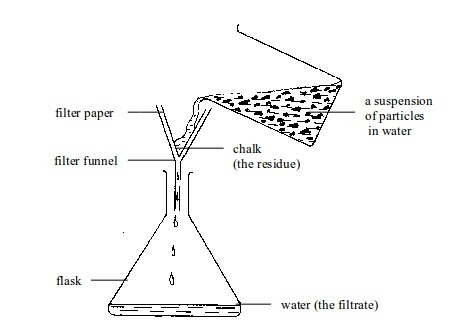
Filtration
2. Decantation
This is another method that can be used to separate mixtures called suspensions. However, in this case, separation will be successful if the suspended particles are large enough. Otherwise, the decantation exercise should be accompanied by filtration if you want to get a clear liquid.
Once the solid has settled to the bottom of the container (sedimented), the liquid can be carefully poured off. This is called decantation. Decantation can be applied to separate such components as mixtures of mud, sand or gravel in water and so on.
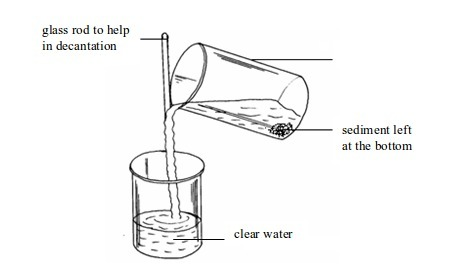
Decantation of muddy water
3. Evaporation
This method is used to separate substances that form a solution. In such a mixture, the solute is completely dissolved in a solvent to make a uniform solution. To separate these substances, the solution is heated so that the solvent evaporates, leaving the solid residue behind.
A mixture of salt or sugar in water can be separated by applying this method.
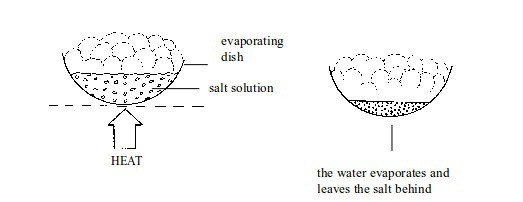
Evaporating the solvent
4. Simple distillation
Separating a liquid from a solution can be carried out by distillation. The boiling point of a liquid is usually very much lower than that of the dissolved solid. The liquid can easily be evaporated off in a distillation flask. It is condensed by passing it down a water-cooled condenser and then collected as the distillate
This method can be used to obtain pure water from impure water or from water with dissolved impurities. The process may be used to separate a liquid from a solution or to separate two liquids whose boiling points differ by an appreciable temperature interval. This is a way of getting a pure solvent out of a solution.
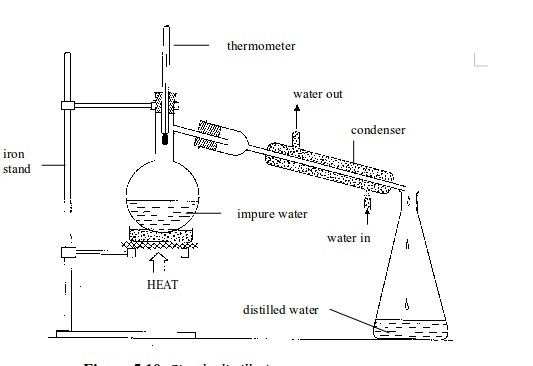
Simple distillation
5. Fractional distillation
Separating the liquids from a mixture of two (or more) miscible liquids is again based on the fact that liquids will have different boiling points. However, the boiling points are closer together than for solid-in-liquid solutions. It is difficult to separate mixtures of liquids whose boiling points differ by only a few degrees. In this case, fractional distillation is used.
For example, ethanol boils at 78°C whereas water boils at 100°C. When a solution of ethanol and water is heated, ethanol and water vapours enters the fractionating column. Evaporation and condensation take place as the vapours rise up the column. Ethanol passes through the condenser first as the temperature of the column is raised above the boiling point. Water condenses in the column and flows back into the flask because the temperature of the column is below its boiling point of 100°C.
The temperature on the thermometer stays at 78°C until the ethanol has distilled over. Eventually, the thermometer reading rises above 78C°. This is a sign that all the ethanol has been separated, so heating can be stopped. By watching the temperature carefully, the two liquids (fractions) can be collected separately.
Various forms of fractionating column can be used. Their general purpose is to provide surfaces, e.g. flat discs, on which ascending vapour can condense. Glass beads in the column provide a large surface area for condensation.
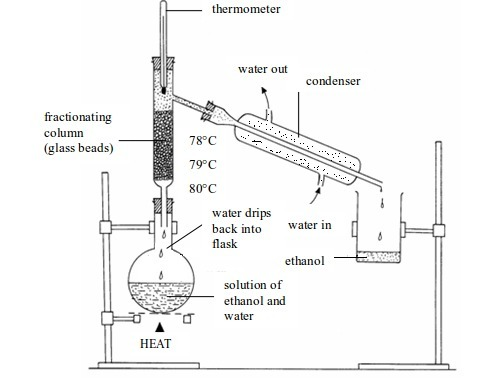
Fractional distillation
6. Sublimation
This is a technique used to separate a mixture of solids where one of the solids sublimes. Examples of solids which sublime are ammonium chloride, iodine, solid carbon dioxide and naphthalene. A mixture of any of these solids with another solid can be separated by sublimation.
Let us consider a mixture of iodine and sodium chloride. The mixture is placed in a beaker and covered with a filter funnel as shown in the diagram below. Then, as the mixture is heated, the ammonium chloride sublimes. The ammonium chloride vapour rises and condenses on the cooler walls of the filter funnel. The sodium chloride is left in the beaker.
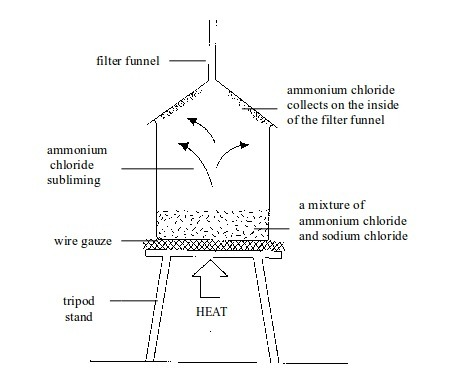
Sublimation of ammonium chloride
7. Chromatography
This method is commonly used to separate a mixture of coloured substances (solids or dyes). An example of this is the separation of dyes that make up black ink. Chromatography works better when a solvent is used. The commonest solvent is water, though other solvents such as ethanol or ether may be used for those substances that do not dissolve in water. There are two types of chromatography, namely column chromatography and paper chromatography. The two types of chromatography follow the same principle, but paper chromatography is the simplest form to set up, and hence is more commonly used. On which principle does chromatography work? Let us consider an example of separating dyes that make up black ink. In this case, water is used as a solvent.
Separating dyes in ink
Procedure
- Put a small spot of the water-soluble ink onto a strip of filter paper as shown in figure bellow
- Place the filter paper in a beaker of water. Make sure the level of the water is below the level of the ink spot.
- Leave the filter paper until the water has risen to the top of the paper.
- Remove the paper and allow it to dry.
- Note the colours the ink contains.
Observation

Separating the components of black ink by paper chromatography
As the solvent (water) moves up the paper, the dyes are carried with it and begin to separate. They separate because they have different solubilities in water and are absorbed to different degrees by the filter (chromatography) paper. As they rise, they are gradually separated.
Findings
The different colours of the ink make a pattern of colours formed during the process of chromatography. This pattern of colours is called a chromatogram.
Figure aboveshows a chromatogram of black ink. The blue ink has the fastest speed. This means it is the most soluble in water and least absorbed by the paper. The green ink has travelled least. This means it is the least soluble in water and most absorbed by the paper.
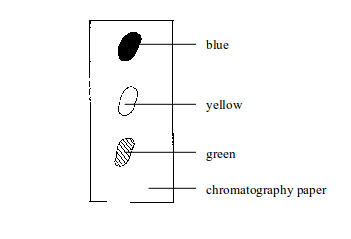
Paper chromatography showing the separated components of black ink
Uses of Chromatography
Chromatography is used in many different ways. The following are some of the application of chromatography:
- It can be used to find out the components of a liquid or solid, or even to identify different substances.
- It can be used by security agents and medical personnel to analyse blood and urine samples.
- Causes of pollution in water and in animals that live in water can also be detected using chromatography.
- In chemistry, chromatography is used to test the purity of substances and in separation of mixtures.
8. Layer separation
Mixtures of two immiscible liquids can be separated with a separating funnel. The mixture is placed in a separating funnel and allowed to stand. The liquids separate into two different layers. The lower denser layer is then "tapped" off at the bottom.
For example, when a mixture of kerosene and water is poured into the funnel, the kerosene floats to the top as shown in figure above. When the tap is opened, the water runs out. The tap is closed again when all water has gone, leaving the kerosene in the funnel.
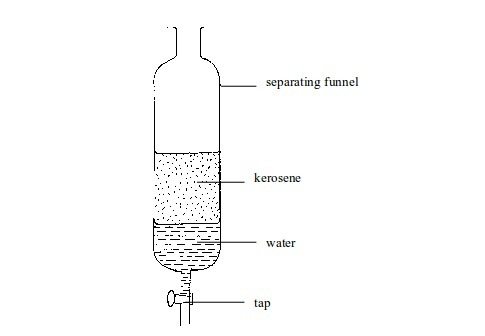
Separating immiscible liquids
9. Solvent extraction
Solvent extraction, also known as liquid-liquid extraction, refers to the separation of materials of different chemical types and solubilities by selective solvent extraction. That is, some materials are more soluble in one solvent than in another. The method is used to refine petroleum products, chemicals, vegetable oils, and vitamins.
This method is used is to separate a solid from a solution in which there is more than one solid dissolved. An example of this is a water solution of iodine and sodium chloride.
EXPERIMENT:Separating iodine from sodium chloride by solvent extraction.
Method
- Put the solution into a separating funnel as shown in figure (a).
- Add ethoxyethane. This forms a layer on top of the solution (b). The ethoxyethane is called the extracting solvent.
- Stopper the separating funnel and shake well figure (c). The iodine, which is more soluble in the ethoxyethane, passes into the ethoxyethane layer. The sodium chloride remains in the water layer.
- The water layer is run off into a beaker followed by the ethoxyethane layer into another beaker (Caution: Remove the stopper before opening the tap).
- The ethoxyethane is then evaporated off by simple distillation. Similarly, the water layer can be evaporated to yield sodium chloride.
The solvent extraction works on two principles:
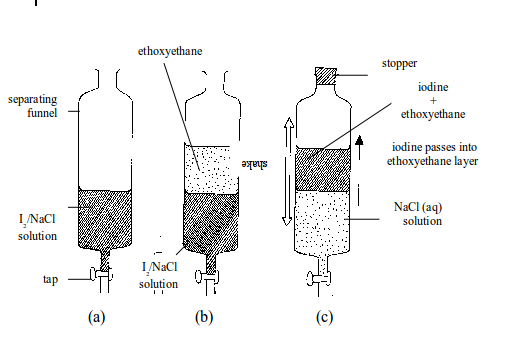
Separating iodine from sodium chloride by solvent extraction
- One solid in the solution must be more soluble in the extracting solvent than the other.
- The extracting solvent must not be miscible with the solvent in which the mixture of solids is dissolved. Neither should it react with it.
10. Centrifugation
A centrifuge is used to separate small amounts of suspension. Centrifugation is used with insoluble solids where the particles are very small and spread throughout the liquid. In centrifugation, test tubes containing suspensions are spun round very fast. The solid gets thrown to the bottom. Here, it is no longer the force of gravity on the solid that causes settling.
Instead, there is a huge centrifugal force acting on the particles due to the high speed spinning of the samples. This causes the solid to be deposited at the bottom of the centrifuge tube.
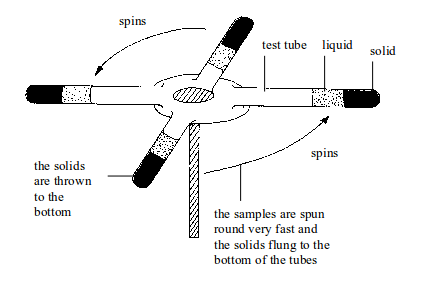
Separation by centrifugation
After centrifugation, the liquid can be decanted (poured out) from the test tube, or removed with a small pipette.
This makes the solid to be left behind.

The solid after centrifugation
11. Magnetic separation
If the solid mixture contains iron, the iron can be removed using a magnet. This method is used to separate scrap iron from other metals. Magnetic iron ore can be separated from other material in the crushed ore by using an electromagnet. In the process of recycling metals, iron objects can be picked out from other scrap metals using electromagnets.
12. Crystallization
This process involves evaporation but the speed of evaporation is much slower. In principle the salt solution can be left in the evaporating basin for a long period until all the water has evaporated but in practice this takes longer time. The process begins by evaporating away the liquid. However, because the crystals are needed, evaporation is stopped after the solution has been concentrated enough. The concentrated solution is allowed to cool slowly and crystallize. The crystals so formed can be filtered off and dried. A similar process is used to extract salt from the sea. Salty sea water is placed in wide basins and put in the sun. Water evaporates off, leaving the salt crystals in basins.
13. Winnowing or threshing
This is a method used to separate grains from husks or bran. The process makes use of the differences in density of the constituents in the mixture. When the winnower is shaken around, grains, being denser than husks or bran, sink to the bottom of the winnower
The less dense husks or bran moves to the top. They are then blown off the winnower by wind or breath, or sometimes picked by hand and separated from the grains.

Separating thresh from grains by winnowing
The Significance of Separating Different Mixtures
Explain the significance of separating different mixtures
We separate mixtures in order to obtain the mixture constituents and put them into appropriate use. The world around us is made up of mixtures of different substances. These substances are often of little use when they are in the form of a mixture. For this reason, separation of the individual components of mixtures is deemed inevitable.
1. (i) Fractional distillation
Is used industrially to separate the various fractions of crude oil such as natural gas, petrol, kerosene, diesel, lubricating oils, waxes, asphalt and bitumen. All these fractions have a significant use in man’s industrial, domestic and commercial activities. The functions or use of all these fractions is well known to everyone of us. Can you mention the functions of each fraction? You will learn more about these products in organic chemistry section.
(ii) Fractional distillation of liquid air
Separates the air into its component gases. This is important because these components have many uses in our everyday life. Some of these fractions and their functions are summarized below:
| Component | Use |
| Nitrogen | Manufacture of fertilizer |
| Oxygen | Used in hospitals, steel making, diving and space travel |
| Argon | Filling light bulbs |
| Carbon dioxide | Fire extinguishing, used in carbonate drinks, etc. |
| Helium | Filling airships and water balloons |
| Krypton and Xenon | Used in photographic flash lamps |
2. Filtration and purification of drinking water make use of processes such as decantation, filtration and sometimes distillation. The bottled water we drink is prepared by some or a combination of these processes.
3. In mining, an electromagnet is used to separate magnetic iron ore from other materials in the crushed ore.
4. In the manufacture of ethanol by fermentation in breweries, distillation is used in the final stage to purify ethanol to its purest form (surgical spirit) in which the ethanol is usually sold. Likewise, distillation of fermented starch (8-12% ethanol), yields alcoholic drinks called sprits (whisky, gin, brandy, rum) which contain about 35-40% ethanol.
5. (i) Paper chromatography is very useful in analysis of substances present in a solution. For example, it can tell whether a substance has become contaminated or otherwise. This can be very important, because contamination of food or drinking water, for instance, may be dangerous to our health.
(ii) Chromatography has proved very useful in the analysis of biologically important molecules such as sugars, amino acids, and nucleotide bases. Molecules such as amino acids can be seen if the paper is viewed under ultra- violet light.
(iii) Paper chromatography is the test that can be used to check for the purity of a substance. If the sample is pure, it should only give one spot when run in several different solvents.
6. Other separation methods are also used to check whether purification has been successful. Samples obtained by distillation can be re-distilled. The purity of crystals can be improved by re-crystallisation. A water sample can be tested for amount of dissolved material by evaporating a certain amount of water to dryness. The solid waste can be weighed. This would give the amount of dissolved solid in the water.
The process of purification is of crucial importance in many areas of chemical industry. Medical drugs (pharmaceuticals) must be of highest possible degrees of purity. Any contaminating substances even in very small amounts may have harmful side effects.
7. (i) Separation of cream from whole milk is done by the process of centrifugation. As the milk is spun, the heavier contents are forced down and the lighter cream rises up. After centrifugation, the cream is poured off the top by decantation. This is the initial stage of milk constituent separation, after which other components such as milk proteins (cheese) are separated.
(ii) Centrifugation is applicable in blood analysis, where the solid part of blood is separated from the liquid part by centrifugation. Blood is a suspension containing microscopic blood cells (corpuscles) in a liquid called plasma. If blood is centrifuged in a test tube, the blood cells are flung to the bottom, leaving the liquid plasma on top.
8. Knowledge of separation of two immiscible liquids can be applied in the extraction of metals such as iron from their ores. For example, at the base of the blast furnace, the molten slug forms a separate layer on top of the liquid iron. The two can then be "tapped" off separately. The method is very useful in organic chemistry as part of the process called solvent extraction.
9. Evaporation process is used in the extraction of common salt from seawater whereby the sun evaporates water molecules from salty water, leaving crystals of the salt behind.
10. Layer separation technique is applied in the recovery of liquids from contaminants.
11. Solvent extraction process is applied in the extraction of certain edible oils from seeds, and in the extraction of some metals from sludge mixture.






EmoticonEmoticon